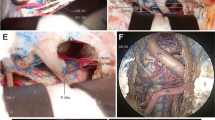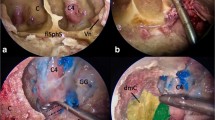Abstract
The endolymphatic sac (ES) and the vestibular aqueduct (VA) are often in the surgical field when posterior fossa lesions are targeted using retrosigmoid approaches. The purpose of this work is to validate neuronavigator accuracy in predicting VA location as well as to give guidelines to preserve the ES and VA. A retrosigmoid approach was performed bilaterally in six specimens in the semisitting position. Preoperatively, we registered in the CT scans the position of the VA genu (virtual genu). After the approach execution, ES and VA genu topographic relationships with evident posterolateral cranial base structures were measured using neuronavigation. Next, we exposed the VA genu: its position coincided with the virtual VA genu in all the specimens. On the average, the ES was 17.93 mm posterosuperolateral to the XI nerve in the jugular foramen, 12.26 mm posterolateral to the internal acoustic meatus, 20.13 mm anteromedial to the petro-sigmoid intersection at a point 13.30 mm inferior to the petrous ridge. The VA genu was located 7.23 mm posterolateral to the internal acoustic meatus, 18.11 mm superolateral to the XI nerve in the jugular foramen, 10.27 mm inferior to the petrous ridge, and 6.28 mm anterolateral to the endolymphatic ledge at a depth of 3.46 mm from the posterior pyramidal wall. Our study demonstrates that is possible to use neuronavigation to reliably predict the location of the VA genu. In addition, neuronavigation may be effectively used to create a topographical framework that may help maintaining the integrity of the ES/VA during retrosigmoid approaches.




Similar content being viewed by others
References
Ammirati M, Ma J, Cheatham ML, Maxwell D, Bloch J, Becker DP (1993) Drilling the posterior wall of the petrous pyramid: a microneurosurgical anatomical study. J Neurosurg 78(3):452–455
Ammirati M, Spallone A, Feghali J, Ma J, Cheatham M, Becker D (1995) The endolymphatic sac: microsurgical topographic anatomy. Neurosurgery 36(2):416–419
Arenberg IK, Marovitz WF, Shambaugh GE Jr (1970) The role of the endolymphatic sac in the pathogenesis of endolymphatic hydrops in man. Acta Otolaryngol Suppl 275:1–49
Domb GH, Chole RA (1980) Anatomical studies of the posterior petrous apex with regard to hearing preservation in acoustic neuroma removal. Laryngoscope 90(11 Pt 1):1769–1776
Ebner FH, Kleiter M, Danz S, Ernemann U, Hirt B, Löwenheim H, Roser F, Tatagiba M (2014) Topographic changes in petrous bone anatomy in the presence of a vestibular schwannoma and implications for the retrosigmoid transmeatal approach. Neurosurgery. doi:10.1227/NEU.0000000000000454
Friberg U, Jansson B, Rask-Andersen H, Bagger-Sjöbäck D (1988) Variations in surgical anatomy of the endolymphatic sac. Arch Otolaryngol Head Neck Surg 114(4):389–394
Geurkink NA (1977) Surgical anatomy of the temporal bone posterior to the internal auditory canal: an operative approach. Laryngoscope 87(6):975–986
Kartush JM, Telian SA, Graham MD, Kemink JL (1986) Anatomic basis for labyrinthine preservation during posterior fossa acoustic tumor surgery. Laryngoscope 96(9 Pt 1):1024–1028
King WA, Wackym PA (1999) Endoscope-assisted surgery for acoustic neuromas (vestibular schwannomas): early experience using the rigid Hopkins telescope. Neurosurgery 44(5):1095–1100, discussion 1100–1102
Lo WW, Daniels DL, Chakeres DW, Linthicum FH, Ulmer JL, Mark LP, Swartz JD (1997) The endolymphatic duct and sac. AJNR Am J Neuroradiol 18(5):881–887
Pillai P, Sammet S, Ammirati M (2008) Application accuracy of computed tomography-based, image-guided navigation of temporal bone. Neurosurgery 63(4 Suppl 2):326–332, discussion 332–333
Pillai P, Sammet S, Ammirati M (2009) Image-guided, endoscopic-assisted drilling and exposure of the whole length of the internal auditory canal and its fundus with preservation of the integrity of the labyrinth using a retrosigmoid approach: a laboratory investigation. Neurosurgery 65(6 Suppl):53–59, discussion 59
Samii A, Brinker T, Kaminsky J, Lanksch WR, Samii M (2000) Navigation-guided opening of the internal auditory canal via the retrosigmoid route for acoustic neuroma surgery: cadaveric, radiological, and preliminary clinical study. Neurosurgery 47(2):382–387, discussion 388
Shimizu S, Tanaka R, Oka H, Fujii K (2006) Risk of damage to the endolymphatic sac and duct during removal of the posterior meatal wall: an anatomic study. Neurosurgery 59(4 Suppl 2):ONS435–ONS439, discussion ONS439–440
Conflict of interest
The authors report no conflict of interest.
Author information
Authors and Affiliations
Corresponding author
Additional information
Comments
Nicholas C. Bambakidis, Cleveland, USA
This is an anatomic paper investigating the usefulness of neuronavigation in aiding identification of and preservation of the endolymphatic sac (ES) and vestibular aquaduct (VA). The authors have produced a nice set of data from their cadaveric dissections; as with all such papers, the actual utility of the data is dubious. Nevertheless, we have found that careful study of the anatomic relationships between these landmarks can be of use in many surgical procedures around the internal auditory canal and cerebellopontine angle.
Atul Goel, Mumbai, India
The endolymphatic sac and duct are important structures that innocuously occupy a position in the petrous bone limited anteriorly by the 7th to 11th nerve complexes, superiorly by the petrous ridge and posteriorly and inferiorly by the sigmoid sinus. Though the retrosigmoid suboccipital approach is a very commonly used approach, the anatomy and preservation of the endolymphatic sac and duct is not a common subject of discussion. The authors have elaborately discussed the anatomy of the endolymphatic system and have elegantly showed the use of neuronavigation to identify and preserve these structures.
The significance of endolymphatic sac and vestibular aqueduct is unclear even to an otolaryngologist. The exact role this anatomical structure plays in hearing and in ‘vertigo’ is more of speculation and individual conjectures. Translabyrinthine approaches will certainly sacrifice the ES and VA. Retrosigmoid operations have the advantage that endolymphatic sac and VA can be preserved. Currently, my surgical strategy in vestibular schwannomas is to avoid drilling of the internal acoustic meatus in most cases. In general, drilling of the internal acoustic meatus should be minimized to 5–6 mm posterolaterally. This avoids injury to the vestibular apparatus, the endolymphatic structures, and a high-riding jugular bulb and avoids opening of the air cells.
Ammirati et al. present a cadaveric study and show the advantages of using navigation system to identify the structure and preserve it. Although technological assistance is always welcome, the well-defined anatomic landmarks and parameters that are the basis of all temporal bone surgery can be foolproof. Essentially, while technology is helpful, the importance of anatomical understanding cannot be ignored.
Despite this, the endolymphatic sac is a well-defined anatomical entity and should be preserved wherever and whenever possible.
Rights and permissions
About this article
Cite this article
Colasanti, R., Tailor, AR.A., Zhang, J. et al. Image-guided, microsurgical topographic anatomy of the endolymphatic sac and vestibular aqueduct via a suboccipital retrosigmoid approach. Neurosurg Rev 38, 715–721 (2015). https://doi.org/10.1007/s10143-015-0634-2
Received:
Revised:
Accepted:
Published:
Issue Date:
DOI: https://doi.org/10.1007/s10143-015-0634-2




